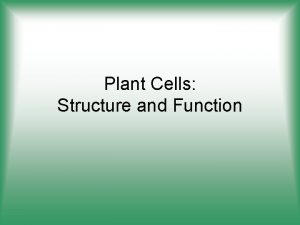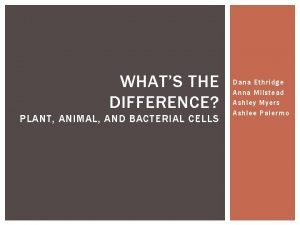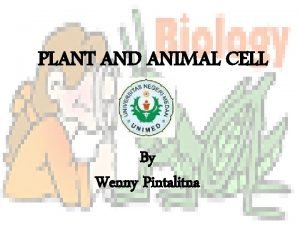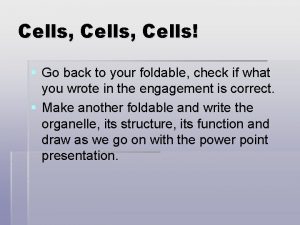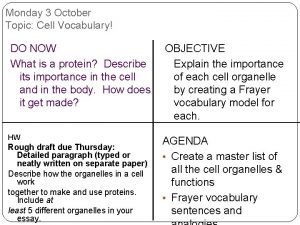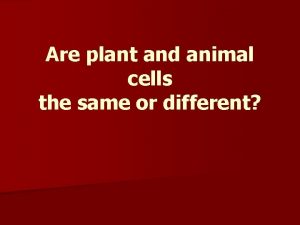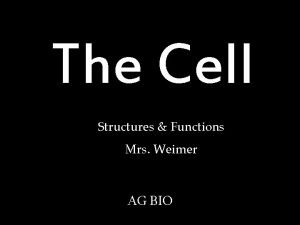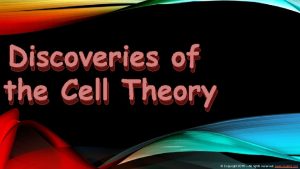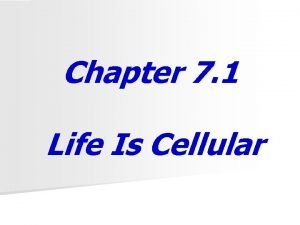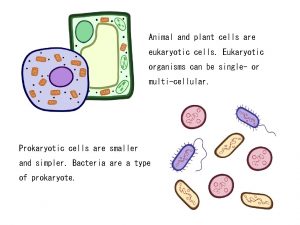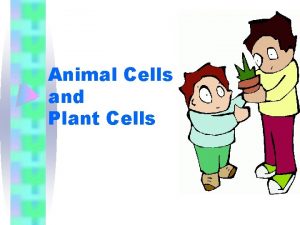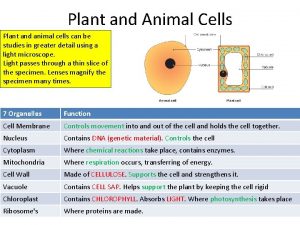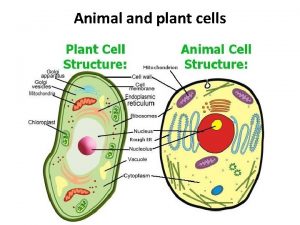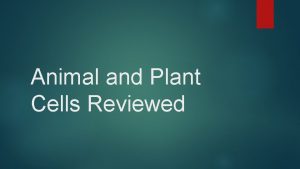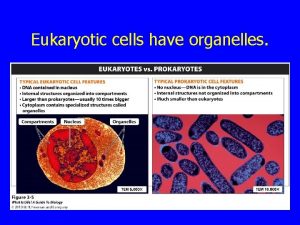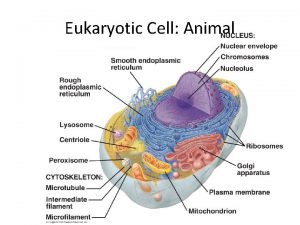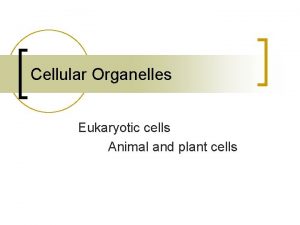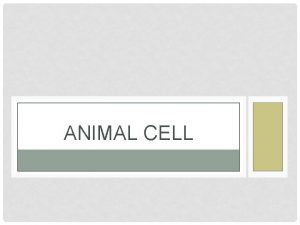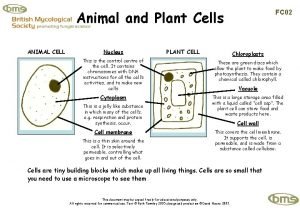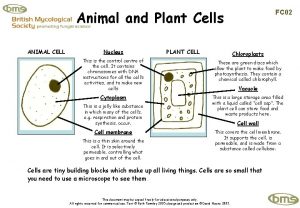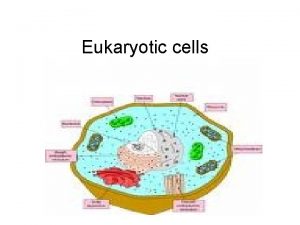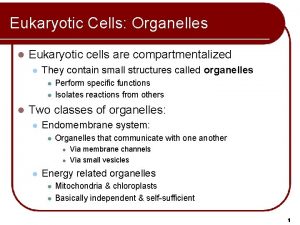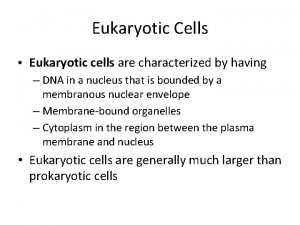Animal Cells versus Plant Cells Eukaryotic cells have






















- Slides: 22

Animal Cells versus Plant Cells

• Eukaryotic cells have a more complex structure than do prokaryotic cells. • Organelles allow for various functions to occur in the cell at the same time • there are some striking differences between animal and plant cells table 1 (see Figure 1).

Comparaison between animal cells versus plant cells • Animal cells Plant cells Centrosomes ((or a pair of centrioles), cell wall, lysosomes, , plasmodesmata chloroplasts, plastids (for storage) central vacuole

Figure 1. (a) A typical animal cell and (b) a typical plant cell.

I. Plant Cells (Des cellules végétales) a. The Cell Wall (La paroi cellulaire) Cell wall: rigid covering that protects the cell provides structural support, gives shape to the cell. e. g Fungal cells and some protist cells also have cell walls. The chief component of prokaryotic cell walls is peptidoglycan, • the major organic molecule in the plant cell wall is cellulose (Figure 2, • •

Figure 2. Cellulose is a long chain of β-glucose molecules connected by a 1– 4 linkage. The dashed lines at each end of the figure indicate a series of many more glucose units.

• cellulose : a polysaccharide made up of long, straight chains of glucose units. • When nutritional information refers to dietary fiber = to the cellulose content of food.

• Plants (autotrophs) : are able to make their own food, like glucose, • whereas animals (heterotrophs) must rely on other organisms for their organic compounds or food source.

Chloroplasts : ( Chloroplastes) ((in green plant cells) • a plastid that contains chlorophyll and in which photosynthesis takes place • . (dans les cellules végétales vertes, une plaste contenant de la chlorophylle et dans lequel se produit la photosynthèse)

• Like mitochondria, chloroplasts have: • outer and inner membranes, • but within the space enclosed by a chloroplast’s inner membrane is a set of interconnected and stacked, fluid-filled membrane sacs called thylakoids (Figure 3).

Figure 3. Chloroplast with membrane, inner membrane, thylakoids, grana, and stroma.

• Each stack of thylakoids is called a granum (plural = grana). • Stroma: The fluid enclosed by the inner membrane and surrounding the grana

• Chlorophyll : is a green pigment contain in The chloroplasts: • Function: captures the energy of sunlight for photosynthesis.

• Examples of cells: • Like plant cells, photosynthetic protists also have chloroplasts. • Some bacteria also perform photosynthesis, but they do not have chloroplasts. • Their photosynthetic pigments are located in the thylakoid membrane within the cell itself.

The Central Vacuole (La Vacuole central) • The central vacuole plays a key role in: • regulating the cell’s concentration of water in changing environmental conditions.

II. Animal cell (Cellule animal) • Without the cell wall, animal cells can be in any sort of shape or size as they are instead surrounded by a plasma membrane. • One thing why animal cells are exclusive because they have centrioles and plant cells do not have centrioles • Centrioles are important for DNA segregation when the cell undergoes the process of mitosis, a process of dividing a cell • Centrioles are important in the structure of the spindles, which helps to pull the chromosomes apart

Constituants of cells cellular constituents function Cell membrane (Membrane cellular) -Separation of the cell from the environment - let the movement of materials in and out of the cell Cytoplasm (Cytoplasme) many functions occur: Including cell division and glycolysis. Golgi apparatus (Appareil de Golgi Modification of proteins sorte, and sent to various parts of the cell. Mitochondria( mitochonries) - respiration of the cell converting glucose into ATP (cellular energy). Ribosome (Ribosome): The m. RNA from the nucleus are used by Ribosomes in a process called translation. -

Translation: is when the Ribosome joins amino acids together according to the sequence of the m. RNA. The more ribosomes in a cell, the proteins it synthesizes. They are located in two areas, on the ER or in the cytosol. Rough Endoplasmic Reticulum (Réticulum - store and transport material through endoplasmique rugueux) : : the cell. - production of Proteins in the ribosomes bound to the rough ER.

Smooth Endoplasmic Reticulum (Réticulum endoplasmique lisse ): - synthesis of lipids - detoxification of drugs and poisons, - storage of calcium ions, - metabolism of carbohydrates A specialized metabolic compartment bounded by a single membrane. Peroxisome (Peroxysome): - Nucleus (noyau) - it possesses enzymes that transfer hydrogen atoms from substrates to oxygen, producing hydrogen peroxide as a by-product. Then, hydrogen peroxide is converted to water by another enzyme. . genetic transcription

Vacuole (Vacuole): the "storage space" : stores water, salt, and other important substances. - food vacuoles : that are cellular organelles in which food is broken down by hydrolytic enzymes. Lysosome (Lysosome): break down cellular wastes such as fats, proteins, or carbohydrates. - purify the cell from materials that are no longer useful. Cytoskeleton (Cytosquelette : - structure made out of protein: - give the cell its shape and structure. - helps cellular motion with the use of flagella, cilia, or lamelllipodia. Centrioles(Centrioles) : used during cell division.

Terminology: Eukaryotic cells: Des cellules eucaryotes: Prokaryotic cells : Des cellules procaryotes Animal cells: Cellules animales: Plant cells: Des cellules végétales Autotrophs: Autotrophes: Heterotrophs: Hétérotrophes: Chlorophylle: Thylakoids: Thylakoïdes:

Inner membrane: : Membrane intérieure Grana: grana Inner membrane: Membrane intérieure: Stroma: stroma Glycosylation : glycosylation
 Animal cell venn diagram
Animal cell venn diagram What cell type
What cell type Typical plant cell
Typical plant cell Eukaryotic cells vs prokaryotic
Eukaryotic cells vs prokaryotic Prokaryotic cells
Prokaryotic cells Staphylococcus aureus prokaryotic or eukaryotic
Staphylococcus aureus prokaryotic or eukaryotic Animal rights versus animal welfare
Animal rights versus animal welfare Whats the difference between animal and plant cells
Whats the difference between animal and plant cells Plant and animal cell venn diagram
Plant and animal cell venn diagram Cloroplasto
Cloroplasto Structure of a animal cell
Structure of a animal cell Paragraph on animal cell
Paragraph on animal cell Difference between simple and complex carbohydrates
Difference between simple and complex carbohydrates Group of multicellular oxygen producers
Group of multicellular oxygen producers Cell theory foldable
Cell theory foldable Plant vs animal cells
Plant vs animal cells Whats the difference between plant and animal cells
Whats the difference between plant and animal cells Different parts of the animal cell
Different parts of the animal cell Differences between plant animal and bacterial cells
Differences between plant animal and bacterial cells Cpalms investigating plant and animal cells
Cpalms investigating plant and animal cells Diffrences between plant and animal cells
Diffrences between plant and animal cells Flexible covering of an animal cell
Flexible covering of an animal cell Carbohydrate side chain
Carbohydrate side chain


